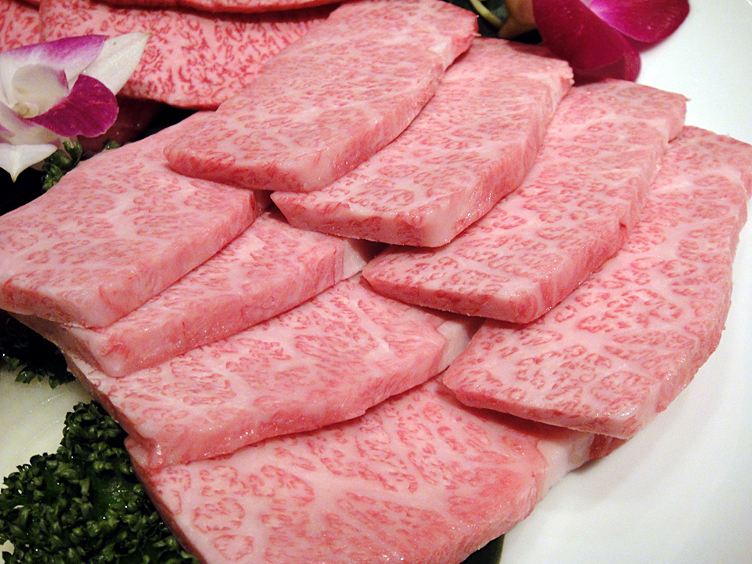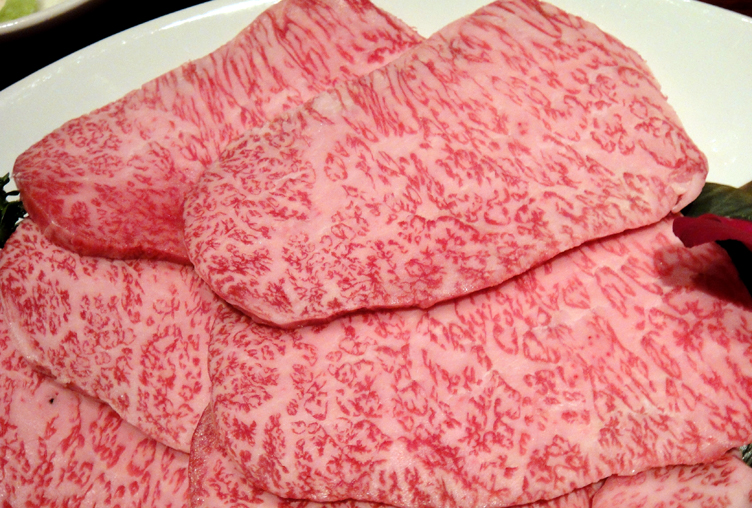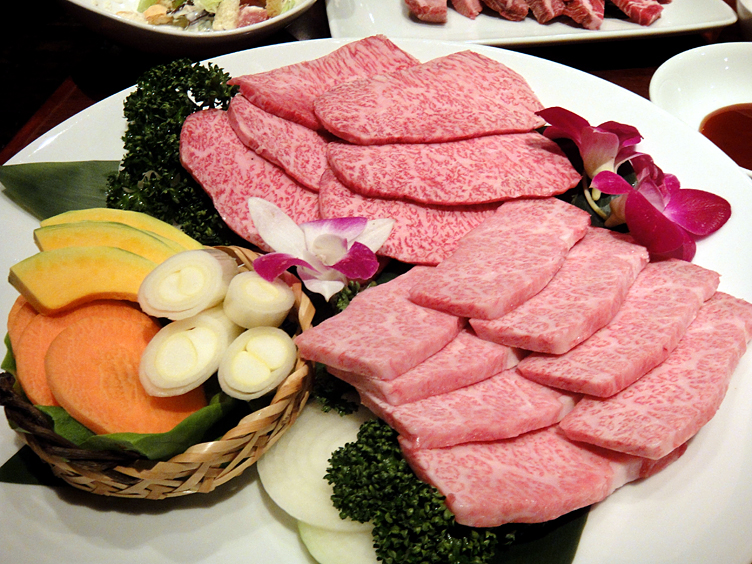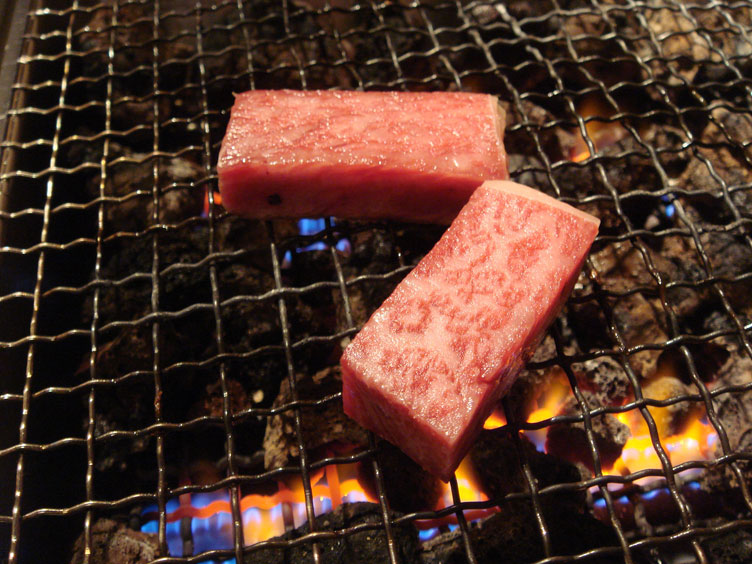A couple of weeks ago a good friend and industry acquaintance took us out to a very lavish meal in Tokyo, the meal was all about Japanese beef and we were able to try Matsuzaka and Mishima Beef accompanied with high quality white rice, vegitables, and Kim Chee… Yakiniku Style!
When I was first introduced to fine Japanese meats about 7 years ago I had a burning desire to eat it as frequently as possible but it seems now the older i get I can’t handle eating as much of it as I used to. The oily and fatty flavors are so rich and delicious you get an angry face as you enjoy it because it’s so amazing. Thank god for the acidity in Kim Chee as it allows me to cleanse my palate before taking another bite of steak.
For those of you who are not familiar with Yakiniku it’s basically a Korean style of cuisine where you sit at a table with open grills while meat and veggies are served to you raw allowing you to prepare it any way you want. The beef is accompanied by various dipping sauces like soy sauce mixed with sake, mirin, sugar, garlic, fruit juice, and sesame but I personally enjoy straight lemon juice to dip my steak into. The word Yakiniku means “grilled meat” and it’s a treat if you have never tried it before.
If you think that we eat great steak in the states you may be shocked at the quality of the beef in Japan, there are many restaurants in America that advertise Waygu or Kobe beef but it just isn’t in the same ball park. In the US, prime beef must have 6-8% of marbled fat to qualify for the highest USDA grade. In order to achieve the highest quality grade for wagyu (A5), the meat must be at least 25% marbled fat. In general, the cattle feed in the US is of lower quality than what is used in Japan, and the individual care for cows is in the two countries varies significantly. Some cattle farmers in Japan are known to treat their cows as members of the family and lavish them with amenities they might not have themselves.
Click “Read More” to see more of my images of the amazing Japanese beef we ate and to read some insane info on what makes Japan’s beef so special…

From the Japan Guide Book:
Fat in Japanese beef is primarily monounsaturated, which is known to lower ‘bad’ cholesterol! Monounsaturated fats also have a very low melting point, making the beef literally melt in your mouth. A steak of top quality A5 grade wagyu can cost $500 or more in Tokyo’s fine dining scene.
Great care is taken to produce marbling, and apart from the being killed and eaten thing, cows in Japan are said to live a king’s (or emperor’s) life. They are fed high quality grains, and each farmer has their own blends and secret ingredients, such as soybeans and okara (a byproduct of making tofu). Water is also an important part in the cattle diet, and local mineral water is often used to ensure the best quality product.
To keep their appetite going during the hot summer months, cows are sometimes fed beer or sake to give them, well, the munchies, which kind of makes you wonder how good the beef would taste if they started mixing pot leaves in the feed. The cows are raised in stalls to help create fatty marbling, so they are taken outside for leisurely walks in the afternoon to get some sun and fresh air.
Some farmers will also spit sake on their cows and rub it in with a straw hand brush, which they say helps balance the distribution of marble content, in addition to keeping the lice and ticks away. In order to ensure their cows stay as relaxed as possible, some breeders are rumored to even play soothing music for them. Beer, massages, afternoon strolls, mineral water, classical music…what a life!
Matsuzaka beef has some of the most expensive cuts, and is considered by many enthusiasts to be the best kind of beef in Japan. Female cows raised in the quiet and serene area around Matsuzaka in Mie Prefecture are slaughtered before being bred, and this virgin meat is said to be the tenderest in the world. Known for its high fat content and characteristic marbling patterns that border on fine art, Matsuzaka beef has a rich, meaty flavor and begins to melt as soon as it enters your mouth.
That’s a lot of money for a little bit of beef. How much does the whole cow cost? A standard Matsuzaka will go for around $10,000 while the most expensive one was sold for $392,000 in 1989…holy cow!
When demand for Kobe beef shot through the roof, American ranchers began using the term ‘Kobe-style’ beef to refer to wagyu cattle raised in the US. While, at $20 per pound for the cheapest Kobe-style beef, it may be much more affordable than their Japanese brethren and of higher quality than American Angus beef, it just doesn’t compare with the real thing.
Fukutsuru 068, a famous wagyu bull was presented to the Americans from Japan in the early 90’s, he deserves a special word of mention. Known for his genetic tendency to produce high levels of marble content in offspring, Fukutsuru is in many ways the father of Kobe-style beef. He was bred countless times and his genes were considered so magical that, prior to his death in 2005, over 100,000 sperm units were collected and put on ice for future generations.
Mishima beef is a rare type of beef that comes from the small island of Mishima Island of the tip of southern Honshu. Unlike Kobe beef, which came from crossing Japanese cows with European breeds, Mishima cattle are pure-bred from the original strain introduced to Japan via Korea over 2,000 years ago. One reason local farmers have been able to prevent interbreeding is because of the isolated location of the island.
Source ( Japan Guide Book )















Tourspec going to diversify their offerings to beef?
no sir I wish but the U.S will not allow Japanese beef in the U.S.
Just as the Japanese will not allow U.S beef into Japan.
If you need good U.S steak or American Waygu visit http://www.allenbrothers.com